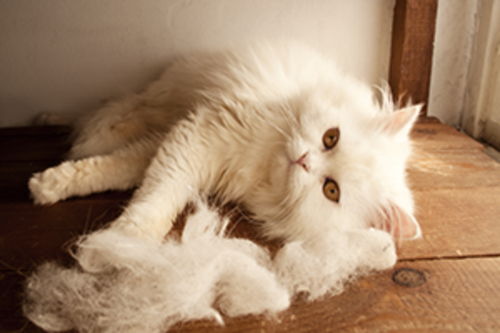Why Is My Pet Shedding So Much?

Have you ever watched pet hair float across the floor like tumbleweeds? If so, you might wonder why your pet sheds so much, and whether it’s normal. Let’s take a closer look at the causes of shedding.
The Shedding Cycle
Both cats and dogs go through annual cycles of shedding. It’s a combination of seasonal changes and hormonal fluctuations.
SPRING: As the sun shines in spring and the days increase in length, fur growth is stimulated hormonally. This means pets not only grow more hair, but lose more hair in turn. Many pet owners find that springtime is peak shed-time.
SUMMER: When the hottest days of summer come, pet hair tends to shed at a faster rate than it it’s replaced. Less hair makes your pet feel cooler and avoid overheating.
FALL AND WINTER: When autumn days lengthen and cool, pets shed their lighter summer coats and grow winter coats. The winter coat is generally fluffier, thicker, and fuller. It often appears to be dual-layered, with a fluffy underlayer and a sleeker top.
Variations in Shedding
Did you notice something interesting about the seasonal shedding cycle explained above? There is no season when pets don’t shed.
It’s a myth that dogs and cats don’t shed in winter, for example. Owners may be confounded to see that pets are still shedding so much fur even as frigid weather sets in, but shedding is a year-round occurrence. It’s simply the quality of the coat that changes.
Pets that spend most of their time indoors are somewhat less susceptible to seasonal changes. In a house with temperature and lighting control, cats and dogs tend to have steadier year-round shedding.
Shedding can also be affected by normal variations in a pet’s life cycle, like age and pregnancy. Puppies shed at a fast rate. And over the course of a lifetime living indoors, a long-haired cat may stop shedding as it grows older.
Certain breeds also go through a dramatic shedding cycle, sometimes called coat blow or blowing through their coat, where almost all the fur is shed in a short period. Siberian Huskies, Samoyeds, Akitas, and Malamutes are common breeds for this type of shedding, and German Shepherds to a lesser degree. Owners will gather bags full of hair during coat blow.
When to Be Concerned
Pet owners often wonder whether their pet’s shedding falls within the normal range. There are certainly environmental stressors and health changes that are cause for concern.
Poor diet. Low-quality food and lack of vitamins can cause excessive shedding, as the animal’s body reacts to a lack of nutrients. This is a particular concern with adopted animals where you don’t know the previous owner’s habits.
Allergies. Many types of allergies can trigger hair loss. It could be from food, a chemical irritant, or something else around your home. Talk to your vet about allergies and hair loss.
Thyroid problems. If your pet’s thyroid begins to malfunction, hair loss can be an early sign. Hair may become patchy or change in texture.
Adrenal disease. Illnesses of the adrenal glands, like Cushing’s disease, can also cause hair loss or changes in hair quality.
Infections and parasites. Skin problems are another cause of hair loss. Fleas, for example, can cause a body-wide shed as the skin and body react to the infestation.
Knowing your pet’s normal shedding pattern may ease your mind about seeing tufts of hair on the floor. It’s also a good idea to consult with a vet for a baseline view of your pet’s hair health, especially when adopting a new pet.
If you’re concerned about excessive shedding, reach out to Academy Animal Hospital for a consultation today.
